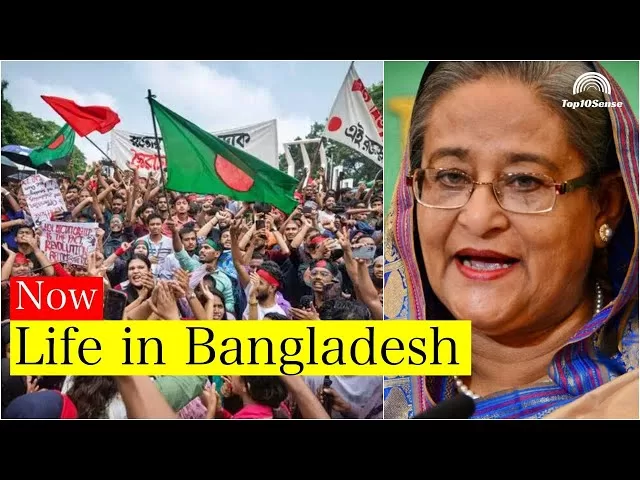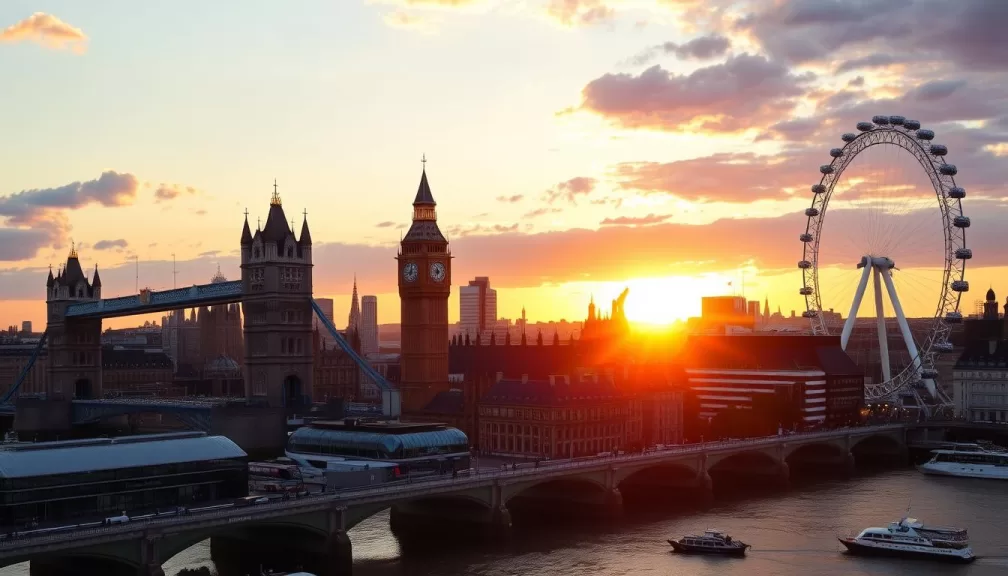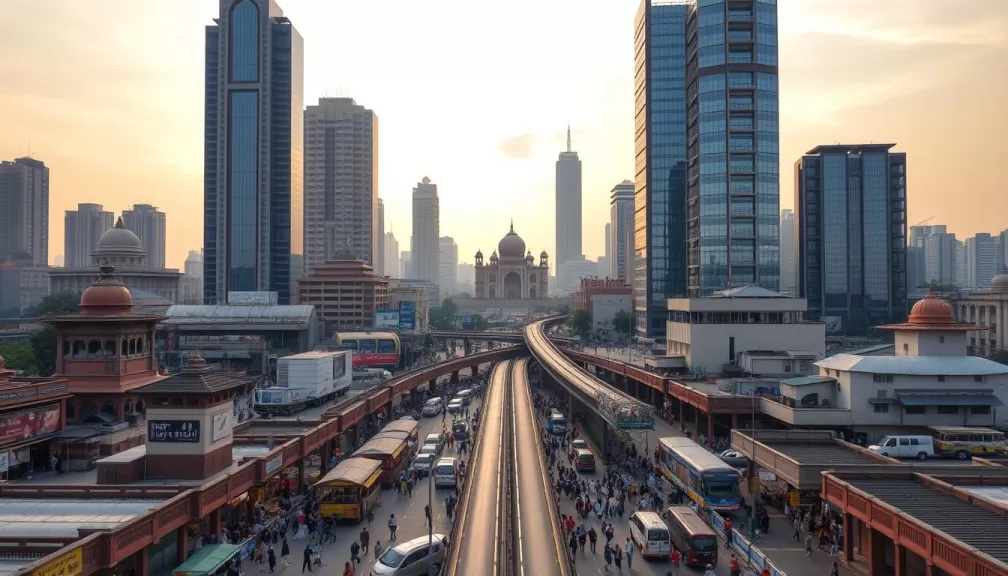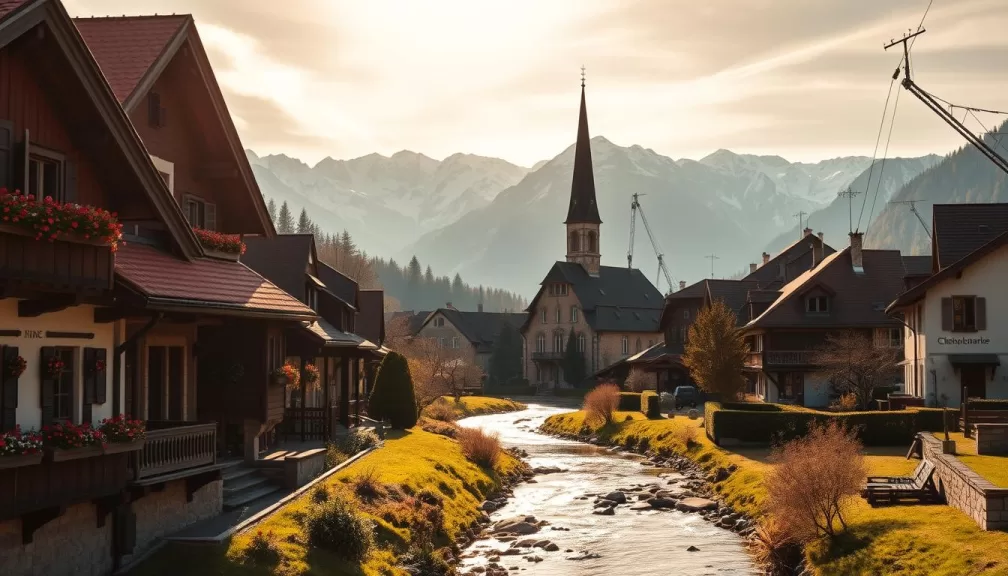I’ve been watching Bangladesh closely, feeling both fascination and worry. This country was known for its economic growth under Prime Minister Sheikh Hasina. But now, it’s caught in a wave of student-led protests. These protests have changed its political scene.
The protests started in July, against a job quota system that favored some families. It was meant to help those from the 1971 war of independence. But it grew into a big movement, with hundreds of thousands of young people taking to the streets.
Things got violent, with nearly 300 protesters killed by security forces. The government’s tough actions, like bullets, curfews, and internet blocks, made things worse. It made people lose trust in their leaders.
Then, the military stepped in, planning to help set up an interim government. This move could bring stability, but it also worries people about the military’s role in politics.
Key Takeaways
- Protests in Bangladesh began over a controversial government job quota system, leading to violent clashes with security forces.
- The unrest resulted in the resignation of Prime Minister Sheikh Hasina after 15 years in power.
- The military has called for calm and promised an interim government, but concerns remain about its role in the country’s political future.
- Economic distress, including limited job opportunities and depleting foreign exchange reserves, have fueled the discontent among Bangladeshi youth.
- The protests have highlighted the growing divide between the country’s economic progress and the rising inequality faced by its citizens.
Introduction: The Rise of Student Protests
Bangladesh has a long history of student-led protests. These started with the Language Movement of 1952 and the Liberation War of 1971. Now, students are again leading protests, fighting for issues like road safety, education reform, and against government corruption.
Social media has helped spread the word and bring more students into the movement. This has made the student protests in Bangladesh stronger.
Background on the Quota System and Its Impact
The quota system is at the center of the protests. It sets aside up to 30% of civil service jobs for descendants of the 1971 independence war veterans. Many students see it as unfair, helping only those close to Prime Minister Sheikh Hasina’s Awami League.
This has made the youth feel left out. They believe the quota system stops them from getting government jobs they deserve.
The Catalyst: The Death of Abu Sayed and the Birth of the “Students Against Discrimination” Movement
The death of 25-year-old student Abu Sayed changed everything. He was shot by police during a protest against the quota system. His death made many students angry and sad.
Thousands then took to the streets to demand justice and end the quota system. This led to the “Students Against Discrimination” movement. It’s now a symbol of the youth’s fight against unfairness and inequality.
“The death of Abu Sayed was the tipping point for us. We will not rest until the quota system is abolished and equality is restored in our country.” – Ravi, a student protest organizer.
Economic Growth and Rising Inequality
Under Prime Minister Sheikh Hasina, Bangladesh has seen huge economic growth. Exports and foreign exchange reserves have gone up a lot. But, this growth has also made the gap between rich and poor bigger, making young people unhappy.
The economy has grown fast, but wealth isn’t spread out evenly. The HIES 2022 says 30.04% of income goes to the top five percent of households. The top 10% now have 40.92% of all income, up from 38.09% in 2016.
But, the bottom 50% of households now get 19.05% of the income, down from 20.23% in 2016. This means many young people can’t find good jobs, making them feel frustrated and let down.
| Indicator | 2016 | 2022 |
|---|---|---|
| Income share held by top 10% of households | 38.09% | 40.92% |
| Income share held by bottom 50% of households | 20.23% | 19.05% |
| Concentration of income in top 5% of households | N/A | 30.04% |
The protesters said the government’s focus on economic progress ignored human rights and democracy. They think the economic growth hasn’t helped everyone equally. This has made people feel unfairly treated.
“The widening gap between the rich and the poor is a sign that the economic model is flawed. Policymakers need to focus on inclusive growth that empowers the poor and the vulnerable.”
– Winnie Byanyima, Executive Director of Oxfam International
Political Unrest and Demands for Change
Bangladesh, once known for its economic success under Prime Minister Sheikh Hasina, is now facing a political crisis. Protesters are demanding her resignation. The movement started with students protesting the government’s quota system. Now, it’s against Hasina’s 15-year rule.
Under Hasina, Bangladesh has seen strong GDP growth and more people have electricity. But, the gap between rich and poor has grown. This has made the youth unhappy.
Protests grew stronger after a student, Abu Sayed, died during a crackdown. Now, people want Hasina to step down and an investigation into the violence. The government’s response, like using tear gas and shutting down the internet, has made things worse.
The crisis in Bangladesh worries the world. The U.S. has put sanctions on a special security group and seven top officers for human rights abuses. The future of Bangladesh’s politics is unclear, with calls for change echoing everywhere.
“The protests in Bangladesh, initially sparked by student grievances, have evolved into a broader movement against Hasina’s leadership.”
Hasina’s Awami League won a big election in January, getting 223 out of 300 seats. But, just seven months later, she’s facing pressure to step down. The protesters’ voices are getting louder.
The unrest in Bangladesh is complex. The country has grown economically under Hasina, but there’s more inequality and a desire for change. The future of Bangladesh’s democracy is uncertain.
Life in Bangladesh NOW: From Prosperity to Protests
Bangladesh has seen great economic growth under Prime Minister Sheikh Hasina. This growth has made the nation proud. But, many Bangladeshis, especially the youth, haven’t seen better lives. They’ve taken to the streets to protest against the government’s strict rule and the big gap between the rich and the poor.
Protests in Bangladesh have started over many issues, like the quota system, civil liberties, and democratic rights. It’s reported that nearly 300 people have died in the unrest. Thousands of opposition members have been arrested since the January election. The international community, including the United States, European Union, and United Nations, has called for peace and restraint.
Despite the government’s efforts, the protests keep getting bigger. Students and their families from schools, colleges, and madrasahs are joining in. The government’s unclear stance on the quota issue has made people doubt their leadership.
“The protests are spreading rapidly like wildfires.”
The situation in Bangladesh is getting more complex. The freedom fighters’ dignity and the quota benefits of their descendants are at risk. The government and protesters can’t agree, making a peaceful end hard to see. The future of Bangladesh’s stability and democracy is uncertain.

Bangladesh’s economic growth and growing discontent show a delicate balance between development and fairness. The world is watching, hoping for a peaceful solution that listens to the Bangladeshi people’s concerns.
Human Rights Concerns and Government Crackdown
The protests in Bangladesh have brought up big human rights worries. The government is accused of ignoring civil liberties and limiting free speech. Over 200 people have died, says local media, due to security forces’ harsh actions.
This tough stance by the government has made things worse. It has made people even more upset.
Violations of Civil Liberties and Freedom of Speech
The government’s way of dealing with protests is getting a lot of criticism. They’ve shut down the internet and set curfews, which has stopped people from speaking out. Journalists and activists are being harassed, threatened, and arrested for covering the protests or supporting them.
The Use of Force Against Protesters and the Resulting Casualties
Security forces have used too much force on the protesters. People have seen chaos, with police and military using tear gas, rubber bullets, and live bullets. Sadly, at least 32 children and over 200 protesters have died.
This aggressive approach has made things worse. People are losing trust in their leaders fast. The world is watching, urging for human rights protection and peace.
“The government’s response to the protests has been a complete disregard for the fundamental human rights of the Bangladeshi people. Their actions have only served to further inflame the situation and erode public trust.”
Environmental Challenges and Rural Development
Bangladesh is facing big environmental challenges because of climate change. This change threatens the lives of people living in rural areas. Floods and cyclones have ruined farmlands and hurt the economy, leading to protests across the country.
The Impact of Climate Change on Bangladesh
Climate change could cut Bangladesh’s GDP by Tk 29,925 million by 2030. About two-thirds of the people live in rural areas and are most at risk. Now, half of rural jobs are not in farming, showing a big change from before.
The rural economy mainly relies on farming but it’s not very productive. It faces problems like a lack of skilled workers, fast population growth, and unstable economy. Also, fixing rural land issues is hard because of poor infrastructure, not enough water, and limited farm support.
| Indicator | Value |
|---|---|
| Rural poverty rate in Bangladesh (2016) | 26.4% |
| Urban poverty rate in Bangladesh (2016) | 18.9% |
| Extreme poverty rate in Bangladesh (2016) | 12.9% |
| Percentage of rural employment in non-farm activities | 50% |
Despite the challenges, Bangladesh has improved rural areas a lot. It built bridges, brought electricity to remote islands, and fixed water problems with pumps. Almost 70% of Union Parishads now have fast internet, helping with better services, more jobs, and stronger communities.
As Bangladesh deals with environmental issues and aims for rural growth, it’s key to tackle these problems. We need to help the rural people and support sustainable growth.
Urbanization and Youth Empowerment
Bangladesh is changing fast, bringing a new wave of young people who want to make a difference. These young people, living in cities, use social media to push for change. They’re leading the call for reforms and accountability from the government through protests.
The Role of Social Media in Mobilizing Protests
Social media has been key in the recent protests in Bangladesh. Young people, upset by corruption, human rights issues, and lack of jobs, use these platforms to spread the word. They organize events, share updates, and call for support, making social media a powerful tool for their cause.
This shows how Bangladesh’s urban, connected youth are stepping up. With more people moving to cities, reaching 46% by 2030 and 58% by 2050, this generation will shape the country’s future. They won’t just accept things as they are.
| Urbanization Statistics in Bangladesh | Data |
|---|---|
| Urban population share | 39% in 2020, projected to reach 46% by 2030 and 58% by 2050 |
| Rural-to-urban migration | Mostly in Dhaka, the capital city |
| Urban poverty concentration | More common than in rural areas, causing “urbanization of poverty” |
| Social security program coverage in urban areas | Only 3.4% of urban households get the primary student stipend, and 2.2% get old-age allowance |
As Bangladesh deals with urbanization and empowering its youth, social media will keep playing a big part. It will help shape the country’s future.
Cultural Heritage and National Identity
Bangladesh’s rich culture and strong national identity are key to the student protests. Young leaders draw inspiration from the country’s fight for freedom and its diverse culture. This pride and sense of belonging drive them to demand a fairer and more democratic Bangladesh.
Ancient Bengal was home to many Hindu and Buddhist kingdoms and empires. Islam became the main religion in the 13th century thanks to Bakhtiyar Khalji’s conquests. The region was known as the richest for trade by Europeans in the 14th century.
The Mughal Empire took over Bengal in the late 16th century. The modern borders of Bangladesh were set in 1947 during the Partition of India, creating East Pakistan. Bangladesh became independent in 1971 after the Liberation War.
Today, Bangladesh’s cultural heritage brings great pride to its people. With 99% of the population being Bengali, the country’s traditions, languages, and religions show its diversity. The Bengali architecture, folk music, and traditional dance forms highlight the resilience and creativity of its people.
“Our cultural heritage is not just a relic of the past; it is a living, breathing part of who we are as Bangladeshis. It is what binds us together and gives us a sense of purpose in our fight for a better future.”
The cultural heritage and national identity of Bangladesh inspire the student protesters. They aim to protect the country’s culture while seeking a fairer and more democratic society.

| Key Fact | Statistic |
|---|---|
| Population Density | 1,165 people per square kilometer (12th globally) |
| Ethnic Composition | 99% Bengali, with smaller minorities |
| Religious Composition | 91.04% Islam, 7.95% Hinduism, 0.61% Buddhism, 0.30% Christianity, 0.12% other religions |
| GDP per capita (2024 PPP) | $9,410 (126th globally) |
| Income Inequality (Gini coefficient) | 49.9 (high level of inequality) |
The Military Intervention and Interim Government
After Prime Minister Sheikh Hasina stepped down, the Bangladeshi military took charge. They aim to bring order and set up an interim government. General Waker-uz-Zaman, the army chief, said he will look into the violent crackdowns on protesters. He promised to hold those to blame accountable. But, many worry that the military’s move could harm the progress towards more democracy and freedom.
The Army’s Promise to Investigate and Punish the Responsible Parties
General Waker-uz-Zaman spoke on TV, promising a deep look into how security forces treated the students. He said the military will find and punish those who used too much force. Protesters are hoping this means more openness and accountability.
| Key Statistics | Details |
|---|---|
| Tk1 crore owed by Shakib Al Hasan to crab suppliers | Shakib Al Hasan, a famous cricketer, is under fire for not paying local crab suppliers. This shows the tough economic and political issues in Bangladesh. |
| Decline in stocks of Beximco Pharma, Sumit, and S Alam | The protests have hit the stock prices of big Bangladeshi companies like Beximco Pharma, Sumit, and S Alam. This shows how the protests affect the economy. |
| Major reshuffle in top army posts with Major Zia being sacked | The Bangladeshi military has seen big changes in leadership, including the firing of Major Zia. This shows the army’s effort to keep control and discipline during these tough times. |
As the military and interim government form, Bangladesh waits to see if the army’s words will lead to real changes. They hope for a more stable and democratic future.
Global Implications and Lessons Learned
The events in Bangladesh show how a strong youth movement can challenge powerful groups. They teach us about the balance between economic growth and democracy. The student-led movement in Bangladesh might inspire others to fight for their rights and shape their future.
The protests in Bangladesh have big effects worldwide. They’ve caught the world’s eye with their size and persistence. They show the need for more transparency, accountability, and social justice. The economic problems caused by the protests warn policymakers about the risks of political instability.
The Bangladeshi protests teach us important lessons. They show how students can lead and keep people supporting them, even when faced with tough measures. Their focus on issues like income inequality and environmental challenges connects with young people everywhere. This makes the Bangladeshi movement a model for others.





